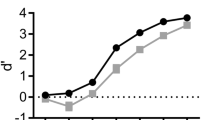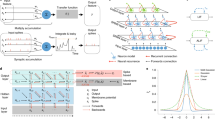Abstract
A computational model is described in which the sizes of variables are represented by the explicit times at which action potentials occur, rather than by the more usual 'firing rate' of neurons. The comparison of patterns over sets of analogue variables is done by a network using different delays for different information paths. This mode of computation explains how one scheme of neuroarchitecture can be used for very different sensory modalities and seemingly different computations. The oscillations and anatomy of the mammalian olfactory systems have a simple interpretation in terms of this representation, and relate to processing in the auditory system. Single-electrode recording would not detect such neural computing. Recognition 'units' in this style respond more like radial basis function units than elementary sigmoid units.
This is a preview of subscription content, access via your institution
Access options
Subscribe to this journal
Receive 51 print issues and online access
$199.00 per year
only $3.90 per issue
Buy this article
- Purchase on Springer Link
- Instant access to full article PDF
Prices may be subject to local taxes which are calculated during checkout
Similar content being viewed by others
References
McClurkin, J. W., Optician, L. M., Richmond, B. J. & Gawne, T. J. Science 253, 675–677 (1991).
Bialek, W. & Rieke, F. Trends Neurosci. 15, 428–434 (1992).
Atick, J. J. Network 3, 213–251 (1992).
Perkel, D. H. & Bullock, T. H. Neurosci. Res. Prog. Bull. 6, 221–248 (1968).
Bullock, T. H. A. Rev. Neurosci. 16, 1–15 (1993).
Burgess, N., O'Keefe, J. M. & Recce, M. in Advances in Neural Information Processing Systems Vol. 5 (eds Hanson, S. J., Giles, C. L. & Cowan, J. D.) 929–936 (Morgan Kaufman, San Mateo, CA, 1993).
Heiligenberg, W. F. Neural Nets in Electric Fish 51–60 (MIT Press, Cambridge, MA, 1991).
Reichardt, W. Z. Naturf. 12b, 448–457 (1957).
Carr, C. E. & Konishi, K. J. Neurosci. 10, 3227–3246 (1990).
Kauer, J. S. Trends Neurosci. 14, 79–85 (1991).
Herz, J., Krogh, A. & Palmer, R. G. Introduction to the Theory of Neural Computation (Addison Wesley, Redwood City, CA, 1991).
Alonso, A. & Llinas, R. R. Nature 342, 175–177 (1989).
Silva, L. R., Amital, Y. & Connors, B. W. Science 252, 432–435 (1991).
Shepherd, G. M. & Brayton, R. K. Brain Res. 175, 377–382 (1979).
Rodieck, R. W. The Vertebrate Retina (Freeman, San Francisco, 1973).
Tank, D. W. & Hopfield, J. J. Proc. natn. Acad. Sci. U.S.A. 84, 1896–1900 (1987).
Kuwabara, N. & Suga, N. J. Neurophysiol. 69, 1713–1724 (1993).
Unnikrishnan, K. P., Hopfield, J. J. & Tank, D. W. IEEE Trans. Signal. Process 39, 698–713 (1991).
Adrian, E. D. J. Physiol., Lond. 100, 459–473 (1941).
Shepherd, G. M. The Synaptic Organization of the Brain 152–183 (Oxford Univ. Press, Oxford, 1979).
Haberly, L. Chem. Senses 10, 219–238 (1985).
Nickell, W. T. & Shipley, M. T. in Science of Olfaction (eds Serby, M. J. & Chobor, K. L.) 172–212 (Springer, New York, 1992).
Laurent, G. & Naraghi, M. J. Neurosci. 14, 2993–3004 (1994).
Delaney, K. R. et al. Proc. natn. Acad. Sci. U.S.A. 91, 669–673 (1994).
Tank, D. W., Gelperin, A. & Kleinfeld, D. Science 265, 1819–1820 (1994).
Shepherd, G. M. The Synaptic Organization of the Brain 289–307 (Oxford Univ. Press, Oxford, 1979).
Eckhorn, R. et al. Biol. Cybern. 60, 121–130 (1988).
Gray, C. M. & Singer, W. Proc. natn. Acad. Sci. U.S.A. 86, 1698–1702 (1989).
Carr, C. E. & Konishi, M. Proc. natn. Acad. Sci. U.S.A. 85, 8311–8315 (1988).
Harnischfeger, G., Neuweiler, G. & Schlegel, P. J. Neurophysiol. 53, 89–109 (1985).
Revial, M. F., Sicard, G., Duchamp, A. & Holley, A. Chem. Senses 7, 175–190 (1982).
Girosi, F. & Poggio, T. Biol. Cybern. 63, 169–176 (1990).
Hossam, O. & Fahmy, M. M. Neural Computat. 6, 927–943 (1994).
Author information
Authors and Affiliations
Rights and permissions
About this article
Cite this article
Hopfield, J. Pattern recognition computation using action potential timing for stimulus representation. Nature 376, 33–36 (1995). https://doi.org/10.1038/376033a0
Received:
Accepted:
Issue Date:
DOI: https://doi.org/10.1038/376033a0
This article is cited by
-
Robust encoding of natural stimuli by neuronal response sequences in monkey visual cortex
Nature Communications (2023)
-
Phase information is conserved in sparse, synchronous population-rate-codes via phase-to-rate recoding
Nature Communications (2023)
-
Moiré synaptic transistor with room-temperature neuromorphic functionality
Nature (2023)
-
Chimera state in a feed-forward neuronal network
Cognitive Neurodynamics (2023)
-
Adaptive Fuzzy Population Coding Method for Spiking Neural Networks
International Journal of Fuzzy Systems (2023)
Comments
By submitting a comment you agree to abide by our Terms and Community Guidelines. If you find something abusive or that does not comply with our terms or guidelines please flag it as inappropriate.



